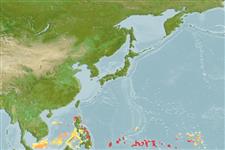Teleostei (teleosts) >
Acanthuriformes (Surgeonfishes) >
Chaetodontidae (Butterflyfishes)
Etymology: Chaetodon: Greek, chaite = hair + Greek, odous = teeth (Ref. 45335).
Eponymy: Dr Warren E Burgess is an American ichthyologist and research scientist who co-wrote: Dr Burgess’s Atlas of Marine Aquarium Fishes (1988) and the Colored Atlas of Miniature Catfish (1992). [...] (Ref. 128868), visit book page.
Environment: milieu / climate zone / depth range / distribution range
Ecology
Marine; reef-associated; depth range 20 - 130 m (Ref. 90102). Tropical; 19°N - 6°N
Western Pacific: Philippines and northeastern Borneo to Flores and Pohnpei. Recently reported from Tonga (Ref. 53797).
Size / Weight / Age
Maturity: Lm ? range ? - ? cm
Max length : 14.0 cm TL male/unsexed; (Ref. 9710)
Dorsal spines (total): 13; Dorsal soft rays (total): 18 - 19; Anal spines: 3; Anal soft rays: 15 - 16. Body is white with broad diagonal black stripes across the body, the first from the origin of the first dorsal spine to the soft portion of the anal fin, the second from just anterior of the dorsal fin extending postero-ventrally ending at about the level of the pectoral fin, and the third running vertically across the eye from the forehead (Ref. 4855). Snout length 2.8-3.0 in HL. Body depth 1.6-1.7 in SL (Ref. 90102).
Occur in drop-offs where gorgonians and black corals are abundant. Usually in depths over 40 m, but in some localities much shallower (Ref. 48636); usually in depths less than 40 m in East Indian region, solitarily or in pairs (Ref 90102). Reported to have been collected from a depth of 380 feet (= 115.8 m) in Palau (J.C. Delbeek, CAS, pers.comm. 10/2017) . Oviparous (Ref. 205). Form pairs during breeding (Ref. 205). They do well in the aquarium and are exported from the Philippines (Ref. 37816). Maximum depth reported taken from Ref. 128797.
Life cycle and mating behavior
Maturity | Reproduction | Spawning | Eggs | Fecundity | Larvae
Form pairs during breeding (Ref. 205).
Myers, R.F., 1991. Micronesian reef fishes. Second Ed. Coral Graphics, Barrigada, Guam. 298 p. (Ref. 1602)
IUCN Red List Status (Ref. 130435: Version 2024-1)
Threat to humans
Harmless
Human uses
Fisheries: commercial; aquarium: commercial
Tools
Special reports
Download XML
Internet sources
Estimates based on models
Preferred temperature (Ref.
123201): 25.7 - 28.7, mean 28 °C (based on 13 cells).
Phylogenetic diversity index (Ref.
82804): PD
50 = 0.5000 [Uniqueness, from 0.5 = low to 2.0 = high].
Bayesian length-weight: a=0.02291 (0.01133 - 0.04632), b=3.00 (2.83 - 3.17), in cm total length, based on LWR estimates for this Genus-body shape (Ref.
93245).
Trophic level (Ref.
69278): 3.5 ±0.37 se; based on food items.
Resilience (Ref.
120179): High, minimum population doubling time less than 15 months (Preliminary K or Fecundity.).
Fishing Vulnerability (Ref.
59153): Low vulnerability (10 of 100).
